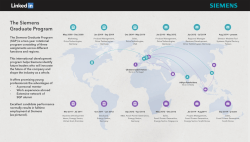
Variability Modeling and Analysis of Value Networks in Software
Jürgen Gegenfurtner Corporate Technology, Software Architecture Development, Software Ecosystems Team Variability Modeling and Analysis of Value Networks in Software Ecosystems Feature-Oriented Software Development Meeting, 14 May 2015 Unrestricted © Siemens AG 2015. All rights reserved A Software Ecosystem consists of … a set of interacting software and service providers and consumers, together with the relationships among them, a common technological base such as a reference architecture, core assets and/or standards. Page 2 May 2015 a shared market for software and services, Members of a software ecosystem may or may not be part of the same organization. Feature-Oriented Software Development (FOSD) Unrestricted © Siemens AG 2015. All rights reserved Software Ecosystem Examples I Page 3 May 2015 Feature-Oriented Software Development (FOSD) Unrestricted © Siemens AG 2015. All rights reserved Software Ecosystem Examples II Page 4 May 2015 Feature-Oriented Software Development (FOSD) Unrestricted © Siemens AG 2015. All rights reserved Software Ecosystem Value Network Fictional Sample Value Network Page 5 May 2015 Feature-Oriented Software Development (FOSD) Unrestricted © Siemens AG 2015. All rights reserved Variability Aware Value Networks Roles can be occupied by several Actors. Business Partners are (a-priori) unknown. Optional Flow: Not all Apps are certified. Value Objects may or may not differ in their functionality and quality. Resources could be shared among Roles or Actors. As-Is vs. To-Be model elements. Internal vs. external Flows. Page 6 May 2015 Feature-Oriented Software Development (FOSD) Unrestricted © Siemens AG 2015. All rights reserved Approach SECO C/V Analysis Siemens Case Studies Literature Review RQ1 Variable Value Network Modeling Approach ? Value Network of Selected Case Study Page 7 May 2015 RQ2 SW Architecture (Same Case Study) Feature-Oriented Software Development (FOSD) Unrestricted © Siemens AG 2015. All rights reserved Discussion Pick any question or ask your own! 1. Does the assumption hold that the value network has an impact on the software architecture? 2. In the value network, should the As-Is and To-Be aspect be treated in the same way as the other variability kinds? If not, how else? 3. Does the inclusion of variability aspects in the value network add unnecessary complexity or is it actually useful for real world scenarios? What do you think? ... Page 8 May 2015 Feature-Oriented Software Development (FOSD) Unrestricted © Siemens AG 2015. All rights reserved Contact You can message me using the following contact information: Jürgen Gegenfurtner Software Ecosystems Team CT RTC SAD ADM-DE Wladimirstr. 3 91058 Erlangen, Germany E-mail: juergen.gegenfurtner.ext@siemens.com siemens.com/innovation Page 9 May 2015 Feature-Oriented Software Development (FOSD) Unrestricted © Siemens AG 2015. All rights reserved Research Questions 1. What kinds of variability exist in software ecosystem value networks? • Which kinds of variability can be deduced or observed? • Which ones are relevant? • Can they be categorized (e.g. “network variety”, “collaboration variety”, ...)? • How can variability be added to the SECO value network modeling approach? 2. (How) Does the value network and its variability influence the software architecture definition process and the resulting artifacts? • Which steps of the architecture definition process can use the value network as valuable input? • Can architectural design decisions be linked to pattern types in the value network? • How do changes in the value network impact the software architecture? Page 10 May 2015 Feature-Oriented Software Development (FOSD) Unrestricted © Siemens AG 2015. All rights reserved Proof of Concept1 The Platform Provider realized many customer segments existed with unique and specific needs the product itself could not satisfy. An ecosystem API to the product was introduced. The API was multi-layered to support the need for protection of sensitive data. Certified extensions had greater access than non-certified ones. Internally, the rest of the product had to adapt to support the differentiation of extensions. 1 Adapted from Bosch, J. & Bosch-Sijtsema, P., ESAO: A Holistic Ecosystem-Driven Analysis Model (2014) Page 11 May 2015 Feature-Oriented Software Development (FOSD) Unrestricted © Siemens AG 2015. All rights reserved
© Copyright 2025










